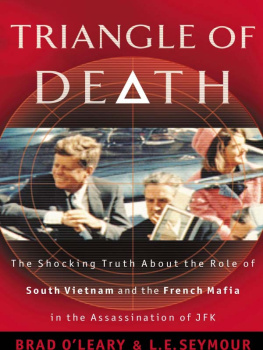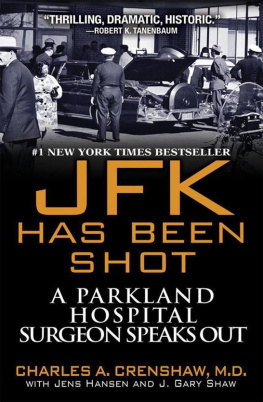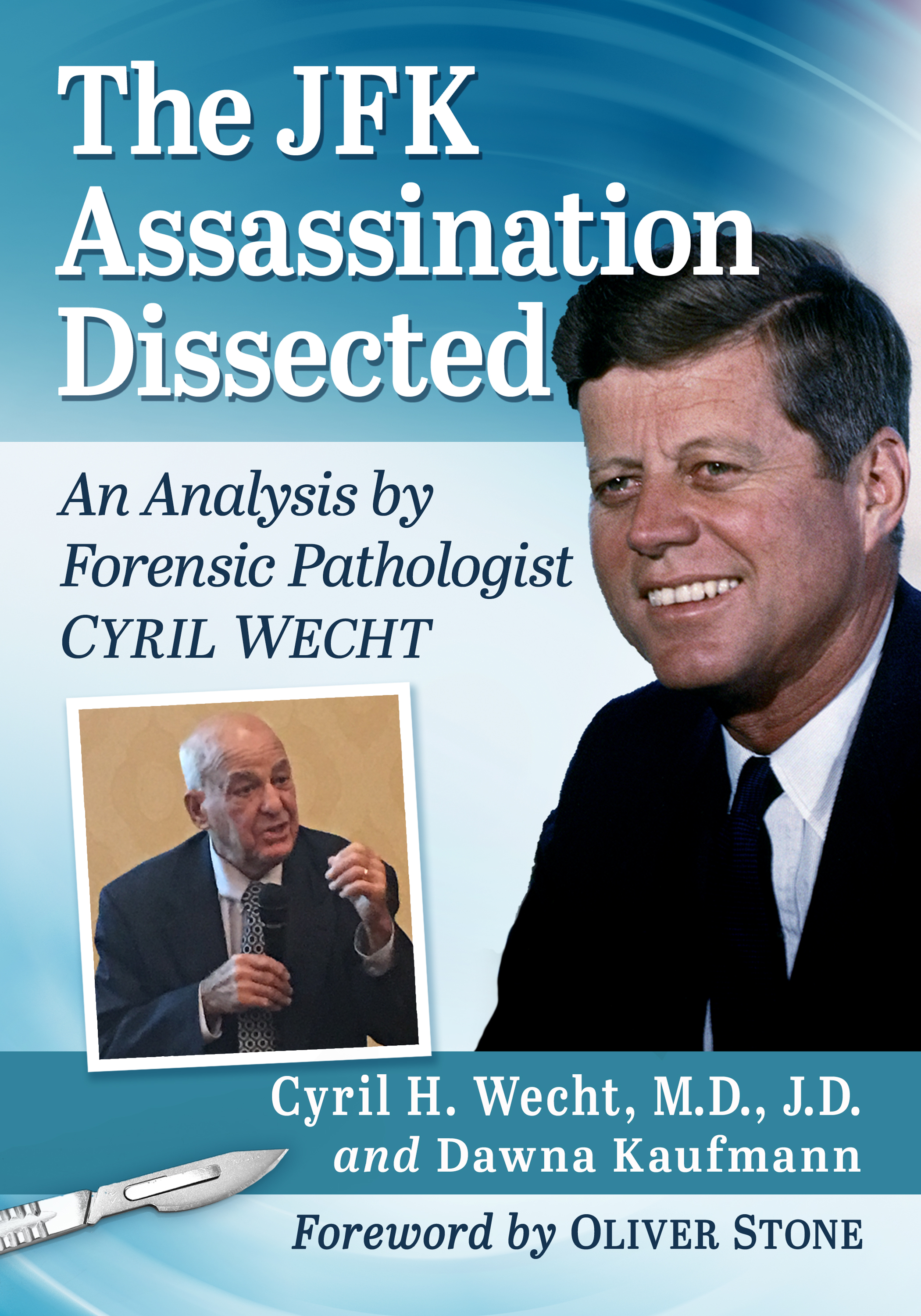The JFK Assassination Dissected
Also by Cyril H. Wecht, M.D., J.D.,and Dawna Kaufmann
Final Exams: True Crime Cases from Forensic Pathologist Cyril Wecht, rev. ed. (2021)
By Cyril H. Wecht, M.D., J.D., and Jeff Sewald
The Life and Deaths of Cyril Wecht: Memoirs of Americas Most Controversial Forensic Pathologist (2020)
Both from McFarland
The JFK Assassination Dissected
An Analysis by Forensic Pathologist Cyril Wecht
Cyril H. Wecht, M.D., J.D., and Dawna Kaufmann
Foreword by Oliver Stone


Jefferson, North Carolina
ISBN (print) 9781476685113
ISBN (ebook) 9781476645445
Library of Congress and British Library cataloguing data are available
Library of Congress Control Number 2021049914
2022 Cyril H. Wecht and Dawna Kaufmann. All rights reserved
No part of this book may be reproduced or transmitted in any form or by any means, electronic or mechanical, including photocopying or recording, or by any information storage and retrieval system, without permission in writing from the publisher.
On the cover left to right : Cyril Wecht (courtesy Andrew Kreig, Esq.); JFK (National Archives); scalpel YJPTO/Shutterstock
Printed in the United States of America
Exposit is an imprint of McFarland & Company, Inc., Publishers


Box 611, Jefferson, North Carolina 28640
www.expositbooks.com
Table of Contents
Foreword by Oliver Stone
The term on the case means that someone is aware of a particular problem and is trying to solve it. The assassination of President John F. Kennedy is a huge problem for American society in manifold ways. And perhaps no one alive has been on that case as long as Dr. Cyril Wecht has.
Cyril is both an attorney and a forensic pathologist. Therefore, he has an effective skill set for peering into the dark corners of what became the official story of Kennedys assassination. From his first exposure to the news, in the offices of his friend and colleague Dr. Thomas Noguchi in Los Angeles, Cyrils curiosity sprang up as certain witnesseslike Abraham Zapruder, and Bill and Gayle Newmanseemed to contradict what was the developing, official story. That story said all the shots came from above and behind the president. Yet these witnesses said the shots came from behind them, and they were all standing in front of the limousine and to Kennedys right.
Then the Warren Commission Report was published, with its accompanying volumes of testimony and exhibits. The doctor now began to examine another serious problem with the official story. A significant number of doctors who treated Kennedy in Dallas said they saw a large hole in the rear of Kennedys skull. One of these witnesses was Kemp Clark. Dr. Clark was chief of neurosurgery at Parkland Memorial Hospital. He was in Trauma Room One with Kennedy. How could he be wrong?
Why was Earl Rose, the medical examiner in Dallas, essentially run over by the Secret Service in its haste to get Kennedys corpse back to Washington? Dr. Rose was a forensic pathologist, and his office was at Parkland Hospital, directly across from Trauma Room One. For whatever reason, Kennedys body was flown to the National Naval Medical Center in Bethesda, Maryland. Physicians James J. Humes and J. Thornton Boswellthe man leading the autopsy and his chief assistantwere not board-certified in forensic pathology. As Cyril notes in this book, there isnt any evidence that either man had ever done a gunshot wound autopsy. This whileas Cyril has told methe leading forensic pathologist in America, Dr. Milton Helpern, was packing his bags and waiting for his phone to ring.
Cyrils reaction to the autopsy report was that it was much too skimpyonly six pages. When he read it, he thought he would not want his name on this document. The Armed Forces Institute of Pathology manual for an autopsy was itself 79 pages long. Perhaps Dr. Helpern could have explained, among many other things, how a single bullet did so much damage to both the president and Governor John Connally,
yet was essentially pristine when recovered, as the government claimed. Would Dr. Helpern have made reference in his autopsy to a civilian witness he never talked to as a guide for the direction of the shots? But further, why did the Warren Commission condone this kind of practice?
Cyril made himself familiar with all these issues and all the 26 volumes of evidence. He studied them for a year. He was then asked by a professional colleague to make an address on the Kennedy case at the annual conference of the American Academy of Forensic Sciences (AAFS) in February of 1966. One of the Kennedy pathologists was in attendance. Dr. Pierre Finck was the most qualified of the original prosectors, but he had arrived to the autopsy after it was already underway. After Cyrils speech, Dr. Finck approached Cyril. He told Cyril: You cannot believe what it was like. It was horrible, horrible. I only wish I could tell you about it.
That AAFS address now made the forensic pathologist the medical man to see for the critics of the Warren Commission Report. The president of the AAFS now began to get calls and meetings with people like Mark Lane and Sylvia Meagher and Josiah Thompson. Through Thompsonwho was working on an article for Life magazineCyril was able to view the Zapruder film at Time-Life in New York. That experience now turned his suspicions about what the Warren Commission had done into a certainty. After watching the differing reactions of Kennedy and Governor John Connally, he now understood that the single bullet theory was not to be taken seriously. It had now, in his description, been reduced to a fantasy.
This work is really two books. It tells the story of Cyril Wecht, as it relates the history of the Kennedy assassination. So readers will not just meet the notable critics named above but also participants in this ongoing drama. Because Cyril was a distinguished professional, he met and debated Arlen Specter, who had served as an assistant counsel for the Warren Commission. (The elevator ride after that encounter is worth reading the book.) Readers will also meet New Orleans D.A. Jim Garrison. The D.A. wanted Cyril to be his expert witness on the autopsy at the trial of Clay Shaw. They went to court to secure Cyrils access to the autopsy materials so he could testify. The judge agreed, but the government lawyers appealed the case. During the investigation of the House Select Committee on Assassinations, Cyril was around for both the first chief counsel, Richard Sprague, and the second, Robert Blakey. The doctor takes pains to note the differences in the two approaches. If readers have not read, listened to, or watched his dissenting opinion before the committee, I strongly advise them to do so. It gives life to the old adage: One man with the truth constitutes a majority.
During that testimony, Cyril noted that, in 1972, he was the first non-governmental forensic pathologist allowed entry into the National Archives in order to inspect the autopsy exhibits. It was his visit that made a disturbing fact public knowledge about President Kennedys brain. I wont spoil the reveal, but this appalling disclosure explains why no medical investigation can now legally certify the findings of the original autopsy. Add to that the admission during the Clay Shaw trial, Dr. Finck admitted that Kennedys back wound was not dissected either. So here was a murder-by-gunshot case where neither wound was tracked through the body to determine trajectory. This would not be acceptable in a big-city homicide case. It should be unthinkable for the murder of the President of the United States.
















